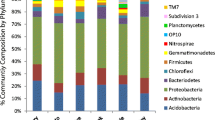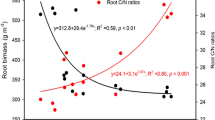Abstract
Semi-natural grassland soils are frequently fertilised for agricultural improvement. This practice often comes at a loss of the indigenous flora while fast-growing nitrogen-responsive species, such as Lolium perenne, take over. Since soil microbial communities depend on plant root exudates for carbon and nitrogen sources, this shift in vegetation is thought to influence soil microbial community structure. In this study, we investigated the influence of different plant species, fertilisation and L. perenne ingression on microbial communities in soils from three semi-natural Irish grasslands. Bacterial and fungal community compositions were determined by automated ribosomal intergenic spacer analysis, and community changes were linked to environmental factors by multivariate statistical analysis. Soil type had a strong effect on bacterial and fungal communities, mainly correlated to soil pH, as well as soil carbon and nitrogen status. Within each soil type, plant species composition was the main influencing factor followed by nitrogen fertilisation and finally Lolium ingression in the acidic upland and mesotrophic grassland. In the alkaline grassland, however, Lolium ingression had a stronger effect than fertilisation. Our results suggest that a change in plant species diversity strongly influences the microbial community structure, which may subsequently lead to significant changes in ecosystem functioning.




Similar content being viewed by others
References
Alef K, Nannipieri P (1995) Methods in applied soil microbiology and biochemistry. Academic, London
Anderson IC, Cairney JWG (2004) Diversity and ecology of soil fungal communities: increased understanding through the application of molecular techniques. Environ Microbiol 6:769–779
Bardgett RD, Mawdsley JL, Edwards S, Hobbs PJ, Rodwell JS, Davies WJ (1999) Plant species and nitrogen effects on soil biological properties of temperate upland grasslands. Funct Ecol 13:650–660
Bardgett RD, Shine A (1999) Linkages between plant litter diversity, soil microbial biomass and ecosystem function in temperate grasslands. Soil Biol Biochem 31:317–321
Benizri E, Amiaud B (2005) Relationship between plants and soil microbial communities in fertilized grasslands. Soil Biol Biochem 37:2055–2064
Bezemer TM, Lawson CS, Hedlund K, Edwards AR, Brook AJ, Igual JM, Mortimer SR, Van der Putten WH (2006) Plant species and functional group effects on abiotic and microbial soil properties and plant-soil feedback responses in two grasslands. J Ecol 94:893–904
Bossio DA, Girvan MS, Verchot L, Bullimore J, Borelli T, Albrecht A, Scow KM, Ball AS, Pretty JN, Osborn AM (2005) Soil microbial community response to land use change in an agricultural landscape of western Kenya. Microb Ecol 49:50–62
Brodie E, Edwards S, Clipson N (2002) Bacterial community dynamics across a floristic gradient in a temperate upland grassland ecosystem. Microb Ecol 44:260–270
Brodie E, Edwards S, Clipson N (2003) Soil fungal community structure in a temperate upland grassland soil. FEMS Microbiol Ecol 45:105–114
Broughton LC, Gross KL (2000) Patterns of diversity in plant and soil microbial communities along a productivity gradient in a Michigan old-field. Oecologia 125:420–427
Cardinale M, Brusetti L, Quatrini P, Borin S, Puglia AM, Rizzi A, Zanardini E, Sorlini C, Corselli C, Daffonchio D (2004) Comparison of different primer sets for use in automated ribosomal intergenic spacer analysis of complex bacterial communities. Appl Environ Microbiol 70:6147–6156
da C Jesus E, Marsh TL, Tiedje JM, de S Moreira FM (2009) Changes in land use alter the structure of bacterial communities in Western Amazon soils. ISME J 3:1004–1011
Day PR (1965) Particle fractionation and particle-size analysis. In: Black CA (ed) Methods of soil analysis, Part 1. American Society of Agronomy, Inc., Madison, pp 545–567
Donnison LM, Griffith GS, Hedger J, Hobbs PJ, Bardgett RD (2000) Management influences on soil microbial communities and their function in botanically diverse haymeadows of northern England and Wales. Soil Biol Biochem 32:253–263
Doran JW, Zeiss MR (2000) Soil health and sustainability: managing the biotic component of soil quality. Appl Soil Ecol 15:3–11
Ehrenfeld JG, Ravit B, Elgersma K (2005) Feedback in the plant-soil system. Annu Rev Environ Resour 30:75–115
FAO (2006). Grassland and pasture crop systems. http://www.fao.org/ag/AGP/AGPC/doc/crops/4d.html. Accessed Oct 2008
Fierer N, Jackson RB (2006) The diversity and biogeography of soil bacterial communities. Proc Natl Acad Sci U S A 103:626–631
Gelsomino A, Keijzer-Wolters AC, Cacco G, van Elsas JD (1999) Assessment of bacterial community structure in soil by polymerase chain reaction and denaturing gradient gel electrophoresis. J Microbiol Methods 38:1–15
Girvan MS, Bullimore J, Pretty JN, Osborn AM, Ball AS (2003) Soil type is the primary determinant of the composition of the total and active bacterial communities in arable soils. Appl Environ Microbiol 69:1800–1809
Grayston SJ, Campbell CD, Bardgett RD, Mawdsley JL, Clegg CD, Ritz K, Griffiths BS, Rodwell JS, Edwards SJ, Davies WJ (2004) Assessing shifts in microbial community structure across a range of grasslands of differing management intensity using CLPP, PLFA and community DNA techniques. Appl Soil Ecol 25:63–84
Grayston SJ, Griffith GS, Mawdsley JL, Campbell CD, Bardgett RD (2001) Accounting for variability in soil microbial communities of temperate upland grassland ecosystems. Soil Biol Biochem 33:533–551
Green BH (1990) Agricultural intensification and the loss of habitat, species and amenity in British grasslands: a review of historical change and assessment of future prospects. Grass Forage Sci 45:365–372
Griffiths RI, Whiteley AS, O’Donnell AG, Bailey MJ (2000) Rapid method for coextraction of DNA and RNA from natural environments for analysis of ribosomal DNA- and rRNA-based microbial community composition. Appl Environ Microbiol 66:5488–5491
Groffman P, Eagan P, Sullivan W, Lemunyon J (1996) Grass species and soil type effects on microbial biomass and activity. Plant Soil 183:61–67
Harris D, Horwáth WR, van Kessel C (2001) Acid fumigation of soils to remove carbonates prior to total organic carbon or carbon-13 isotopic analysis. Soil Sci Soc Am J 65:1853–1856
Hartman WH, Richardson CJ, Vilgalys R, Bruland GL (2008) Environmental and anthropogenic controls over bacterial communities in wetland soils. Proc Natl Acad Sci 105:17842–17847
Innes L, Hobbs P, Bardgett R (2004) The impacts of individual plant species on rhizosphere microbial communities in soils of different fertility. Biol Fertil Soils 40:7–13
Jones DL, Hodge A, Kuzyakov Y (2004) Plant and mycorrhizal regulation of rhizodeposition. New Phytol 163:459–480
Kennedy A, Smith K (1995) Soil microbial diversity and the sustainability of agricultural soils. Plant Soil 170:75–86
Kennedy AC, Gewin VL (1997) Soil microbial diversity: present and future considerations. Soil Sci 162
Kennedy N. (2004). Determination of soil microbial community structure in acidic upland grasslands. PhD thesis. University College Dublin, Dublin.
Kennedy N, Brodie E, Connolly J, Clipson N (2004) Impact of lime, nitrogen and plant species on bacterial community structure in grassland microcosms. Environ Microbiol 6:1070–1080
Kennedy N, Connolly J, Clipson N (2005) Impact of lime, nitrogen and plant species on fungal community structure in grassland microcosms. Environ Microbiol 7:780–788
Kirsten W (1983) Organic elemental analysis: ultramicro, micro and trace methods. Academic, New York
Marschner P, Yang CH, Lieberei R, Crowley DE (2001) Soil and plant specific effects on bacterial community composition in the rhizosphere. Soil Biol Biochem 33:1437–1445
MEA (2005) Ecosystems and human well-being: biodiversity synthesis. World Resources Institute, Washington, DC
Nüsslein K, Tiedje JM (1999) Soil bacterial community shift correlated with change from forest to pasture vegetation in a tropical soil. Appl Environ Microbiol 65:3622–3626
O’Mara F (2008). Pasture profile for Ireland. http://www.fao.org/ag/AGP/AGPC/doc/Counprof/Ireland/Ireland.htm. Accessed Nov 2008
Patra AK, Abbadie L, Clays-Josserand A, Degrange V, Grayston SJ, Guillaumaud N, Loiseau P, Louault F, Mahmood S, Nazaret S, Philippot L, Poly F, Prosser JI, Le Roux X (2006) Effects of management regime and plant species on the enzyme activity and genetic structure of N-fixing, denitrifying and nitrifying bacterial communities in grassland soils. Environ Microbiol 8:1005–1016
Rodwell JS (1992) British plant communities. Cambridge University Press, Cambridge
Scallan U, Liliensiek A, Clipson N, Connolly J (2008) ribosort: a program for automated data preparation and exploratory analysis of microbial community fingerprints. Mol Ecol Resour 8:95–98
Singh BK, Munro S, Potts JM, Millard P (2007) Influence of grass species and soil type on rhizosphere microbial community structure in grassland soils. Appl Soil Ecol 36:147–155
Stoate C, Boatman ND, Borralho RJ, Rio Carvalho C, de Snoo GR, Eden P (2001) Ecological impacts of arable intensification in Europe. J Environ Manag 63:337–365
Tabatabai MA, Bremner JM (1969) Use of p-nitrophenyl phosphate for assay of soil phosphatase activity. Soil Biol Biochem 1:301–307
Thakuria D, Schmidt O, Finan D, Egan D, Doohan FM (2010) Gut wall bacteria of earthworms: a natural selection process. ISME J 4:357–366
Thalmann A (1968) Zur Methodik der Bestimmung der Dehydrogenaseaktivität im Boden mittels Triphenyltetrazollumchlorid (TTC). Landwirtsch Forsch 21:249–257
Tilman D (1987) Secondary succession and the pattern of plant dominance along experimental nitrogen gradients. Ecol Monogr 57:190–214
Torsvik V, Sørheim R, Goksøyr J (1996) Total bacterial diversity in soil and sediment communities—a review. J Ind Microbiol Biotechnol 17:170–178
Vitousek PM, Aber J, Howarth RW, Likens GE, Matson PA, Schindler DW, Schlesinger WH, Tilman D (1997) Human alteration of the global nitrogen cycle: causes and consequences. Issues in Ecology 1:1–16
Vitousek PM, Mooney HA, Lubchenco J, Melillo JM (1997) Human domination of Earth’s ecosystems. Science 277:494–499
Wakelin SA, Macdonald LM, Rogers SL, Gregg AL, Bolger TP, Baldock JA (2008) Habitat selective factors influencing the structural composition and functional capacity of microbial communities in agricultural soils. Soil Biol Biochem 40:803–813
Wardle DA (1992) A comparative assesment of factors which influence microbial biomass carbon and nitrogen levels in soil. Biol Rev 67:321–358
Wardle DA, Bonner KI, Nicholson KS (1997) Biodiversity and plant litter: experimental evidence which does not support the view that enhanced species richness improves ecosystem function. Oikos 79:247–258
Wieland G, Neumann R, Backhaus H (2001) Variation of microbial communities in soil, rhizosphere, and rhizoplane in response to crop species, soil type, and crop development. Appl Environ Microbiol 67:5849–5854
WRI (2000). Grassland ecosystems. http://www.wri.org/publication/pilot-analysis-global-ecosystems-grassland-ecosystems. Accessed Oct 2008
Zak DR, Grigal DF, Gleeson S, Tilman D (1990) Carbon and nitrogen cycling during old-field succession: constraints on plant and microbial biomass. Biogeochemistry 11:111–129
Zak DR, Tilman D, Parmenter RR, Rice CW, Fisher FM, Vose J, Milchunas D, Martin CW (1994) Plant production and soil microorganisms in late-successional ecosystems: a continental-scale study. Ecology 75:2333–2347
Acknowledgements
NC acknowledges funding under the Science Foundation Ireland Research Framework Programme. Useful discussions with Prof. John Connolly as well as operation of the ABI Genetic Analyzer by Maria Benson and Damian Egan are gratefully acknowledged.
Author information
Authors and Affiliations
Corresponding author
Electronic Supplementary Material
Below is the link to the electronic supplementary material.
ESM 1
(PDF 295 kb)
Rights and permissions
About this article
Cite this article
Liliensiek, AK., Thakuria, D. & Clipson, N. Influences of Plant Species Composition, Fertilisation and Lolium perenne Ingression on Soil Microbial Community Structure in Three Irish Grasslands. Microb Ecol 63, 509–521 (2012). https://doi.org/10.1007/s00248-011-9985-6
Received:
Accepted:
Published:
Issue Date:
DOI: https://doi.org/10.1007/s00248-011-9985-6




